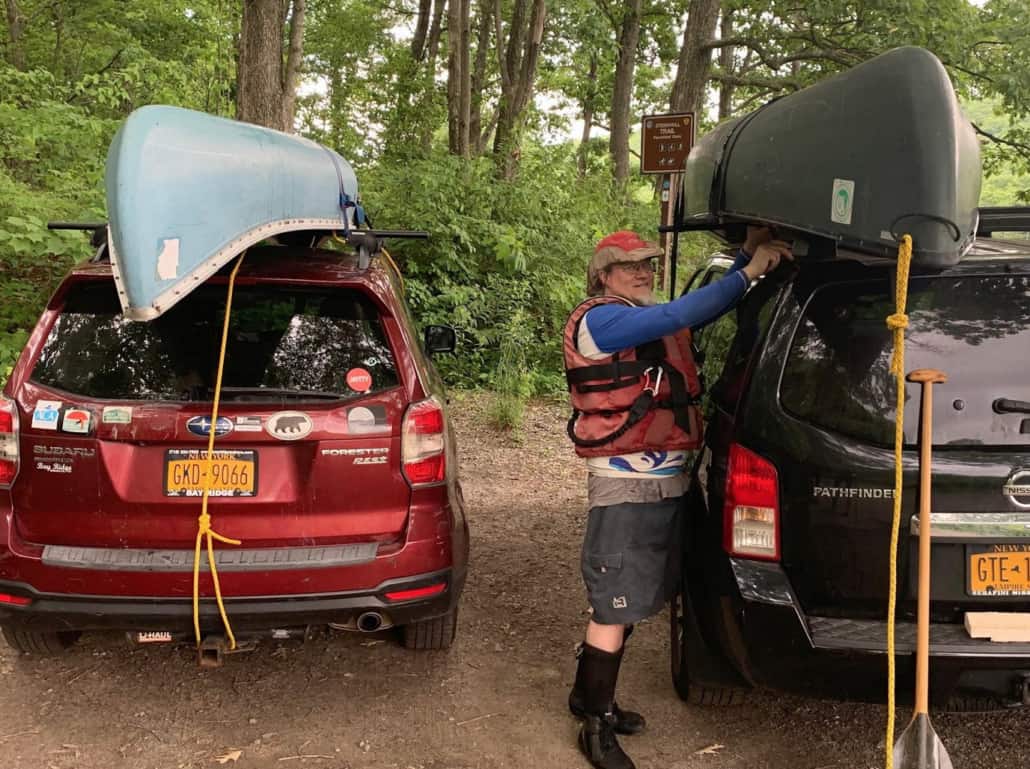Canoe & Kayak Equipment & Gear
Whether you are a Class IV paddler or just getting out on the water, the New York-North Jersey’s Canoe & Kayak Committee (CKC) can help you get started.
Required equipment for canoeing and kayaking
Please see the Equipment Rental section below for information about renting equipment from the Canoe & Kayak Committee. If you bring your own equipment (rather than renting from the Club), you must have a boat, a paddle, personal flotation device (the PFD must be rated for Paddlesport Coast Guard type III or V), spray skirt if appropriate, and a helmet if required. Kayakers will need a spray skirt except on quiet water (QW) trips. If you have any questions about the suitability of your equipment, contact the leader.
In addition to your paddling equipment, you should bring sunscreen, sunglasses (with a retainer like Chums or Croakies to hold them on), insect repellent, and your lunch and water in a waterproof container (e.g., dry bag). All these items should be stored in watertight hatches (e.g., on sea kayaks) or secured in your boat with carabiners or a cord so that they will not be lost in case of an overturned boat. Ensure that securing these items will not interfere with your ability to wet exit! It is also a good idea to keep a waterproof copy of your medical insurance ID card in your life vest in case of an accident.
Private Boat Liability:
The AMC accepts no liability for damage to private boats paddled on its trips. We encourage exchanging partners, trying out new boats, and the lending of boats between private paddlers, but it is done solely at the discretion of, and with the permission of, the private boat owners, and any damage that may result is not the Club’s responsibility.
What you should wear on your paddling trip
A second key factor in dressing appropriately for a paddle is the weather — the most critical factor in deciding what to wear while paddling is the temperature of the water. Even if the water is warm, improperly dressed paddlers get cold quickly if the temperature is cool and the wind is blowing. In cold water, even on a warm day, paddlers without proper clothing face the risk of hypothermia — a potentially life-threatening condition. Indeed, it is no exaggeration to say that hypothermia is perhaps the most severe hazard that paddlers face. For this reason, trip leaders may refuse to allow participation by paddlers who show up without proper clothing.
Paddlers almost never wear cotton clothing because it produces an evaporative cooling effect that will chill you even on a warm day. Unless it is one of those sweltering summer afternoons, you will need clothing designed for cold-weather paddling. A wide variety of paddling apparel is available at paddling shops and websites, including neoprene (used for wet suits), “fuzzy rubber,” and dry suits. Each has its own merits. During the after-dinner campfire discussion at your next paddling trip, ask some of your fellow paddlers for advice on what to get; you will have no shortage of opinions.
Wear something on your feet because rivers and lakes might have broken bottles or other sharp objects that could injure bare feet. Old sneakers are OK, but cold if the water is chilly. The best is wet-suit booties that are designed for paddlers.
Paddler’s Wallet
Think about what would happen to you if you became unconscious and needed help:
- How do you let people know how to proceed?
- How do you make sure the information gets to the right people?
To make sure you’re covered in an emergency, please secure a paddler’s wallet (a slim waterproof container) to your body. Avoid placing anything around your neck, but you can carry it in your personal flotation device (PFD) or around your waist. Place in the wallet a COPY of the following items below (preferably laminated). Keep in mind that ANYTHING on the water WILL get wet and ALWAYS is possible to be lost. Water is a mighty force of nature. It does not matter how hard you try; Mother Nature will always win:
- Driver’s license (for ID). It can be expired, but it should have current mailing info
- Medical insurance card
- Emergency contact info (list people who should be called to get a medical proxy or least made aware of the situation.)
- List of medications/medical conditions/allergies
- Spare credit card
- $20 to $60 in cash (emergencies like a ride back to your car or tip for professionally guided trips)
Camping Gear
Many of our activities are day trips that require no camping gear. To participate in most weekend trips, you will need some essential camping gear and clothing, including a tent, sleeping bag, sleeping pad, flashlight, and other personal equipment.
CKC has cooking kits and various other camping accessories that may be used on the trip.
Renting equipment for canoeing and kayaking
The CKC owns flatwater and whitewater canoes and kayaks, life vests, first aid kits, safety and rescue equipment, and cooking and eating equipment. This equipment is available for participants on paddling trips at a nominal rental fee. The rental rates for our boats are a fraction of what one would pay to a commercial livery. If a boat is lost or damaged on a scheduled trip, the renter’s maximum liability is $50 per person for a tandem boat or $100 per boat for solo boats.
Boats rented from the CKC can be picked up from The Barn on the day of the trip or the Thursday or Friday immediately preceding the trip and must be returned no later than Monday or Tuesday after. If a paddler is signed up on two trips on two consecutive weekends and has obtained prior approval from the Equipment Chair and both trip leaders, a boat may be kept at home in a secure location during the week between trips.
The Chapter’s kayaks may be rented on any Chapter trip. Canoes are available for rental on up to and including Class III whitewater trips. For Class IV trips, solo whitewater canoes may be rented on a case-by-case basis, subject to the approval of the Canoe & Kayak Committee Chair. Learn more about paddling ratings.
Rental fees for a solo boat are $30 for the first day of a trip and $15 per day for each additional day of a trip.
Rental fees for a tandem boat are $40 for the first day of a trip and $20 per day for each additional day of a trip.
To rent/reserve a Club boat for a club trip (excluding paddling instructionals), contact the Equipment Scheduler at canoekayak.equipment@amc-ny.org
Make sure to fill out the form below when taking equipment from the barn: AMC CKC NY-NoNJ Equipment Rental Form.
The CKC has foam blocks and nylon straps in The Barn for those renting a boat. Some blocks are designed to slip over the canoe gunwales or kayak coaming to stabilize a boat that is transported without a roof rack. Others are designed to cradle the hull of the boat. If you plan to paddle often, a better solution is to have a canoe or kayak carrier installed on your car. Thule and Yakima are two popular brands.
How to cartop a canoe
Canoes are always carried upside down (i.e., hull up). If you have a roof rack, nylon straps should loop under the crossbar on one side of the canoe, across the top of the upside-down canoe, and under the crossbar on the other side. If you are using the foam block carriers without a roof rack, you should run the straps over the canoe and through the windows or doors of your car to secure the canoe firmly. In either case, rope or straps should be used to secure the bow and stern of the canoe to the car’s tow hooks or bumpers. Hood loops are great for the front tie-down as most cars have little to no locations for securing the rope in the front of the vehicle.
How to cartop a kayak
Whitewater kayaks are often carried upside down, and sea kayaks are carried right side up. V-shaped foam blocks can be used on your roof rack or directly on the roof of vehicles without racks. When used directly on the vehicle roof, the foam blocks should first be tied in position on the boat with a light cord, and then the boat and blocks together should be secured to the car by running ropes or straps through the door openings. The CKC’s canoe foam blocks from The Barn can be used on most closed boats; take four blocks and place one at each “corner” of the cockpit rim. If you have a roof rack, secure the kayak on the rack with nylon straps as you would a canoe. Use the grab loops at the front and rear of the kayak to secure the boat to the car’s tow hooks or bumper or with hood loops. Always point the front of the kayak towards the front of the vehicle.

